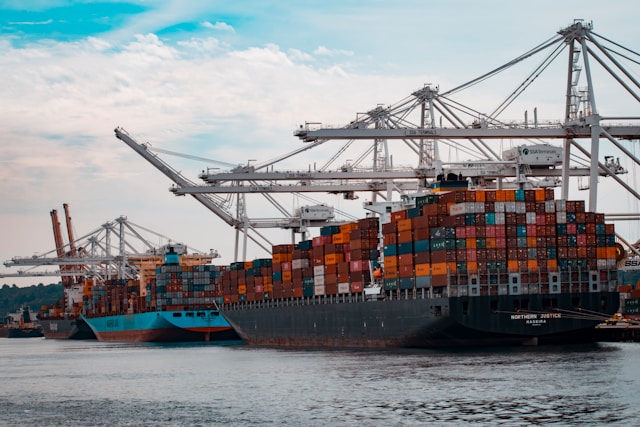ตัวอย่าง Job Description ตำแหน่ง 3rd Party Logistics Officer (3PL Officer) คือบุคคลที่รับผิดชอบในการจัดการและประสานงานกิจกรรมด้านโลจิสติกส์และซัพพลายเชนให้กับบริษัทที่ใช้บริการโลจิสติกส์จากบริษัทภายนอก
Job Descriptions

ลักษณะงานของตำแหน่งนี้ต้องการความสามารถในการวางแผน การจัดการเวลา การสื่อสารที่ดี และความสามารถในการแก้ไขปัญหาเฉพาะหน้า นอกจากนี้ยังต้องมีความรู้ความเข้าใจในระบบโลจิสติกส์และการจัดการซัพพลายเชนเป็นอย่างดี
1. Logistics Planning:
ควบคุมการขนส่งสินค้าจากผู้ผลิตไปยังคลังสินค้า และจากคลังสินค้าไปยังลูกค้าปลายทางพัฒนาและดำเนินแผนโลจิสติกส์เพื่อตอบสนองความต้องการของลูกค้า โดยคำนึงถึงปัจจัยต่างๆ เช่น ระดับสินค้าคงคลัง รูปแบบการขนส่ง และกำหนดการส่งมอบ
2. Order Management:
จัดการและประสานงานการรับ การประมวลผล และการจัดส่ง Order ของลูกค้า ให้แน่ใจว่ามีการติดตามอย่างถูกต้องและการส่งมอบตรงเวลา
3. Transportation Management:
ดูแลการคัดเลือกและการจัดการผู้ให้บริการขนส่ง (3PL) เพื่อให้การขนส่งสินค้ามีประสิทธิภาพและ cost-effective ที่สุด
4. Inventory Management:
ตรวจสอบและจัดการระดับ inventory สินค้าคงคลัง รวมถึงการติดตาม stock levels การระบุแนวโน้ม และการเพิ่มประสิทธิภาพการใช้พื้นที่ storage
5. Compliance and Risk Management:
ควบคุมให้มีการปฏิบัติตามข้อกำหนดทางกฎหมายและมาตรฐานอุตสาหกรรม compliance with regulatory requirements พร้อมทั้งระบุและลดความเสี่ยงที่อาจเกิดขึ้นในlogistics operations
6. Communication and Collaboration:
สร้างความสัมพันธ์ที่ดีกับ internal stakeholders (e.g., sales, production), external partners (e.g., 3PL carriers, suppliers), และลูกค้า เพื่อให้การดำเนินงานโลจิสติกส์ราบรื่น
7. Reporting and Analysis:
จัดทำรายงาน logistics performance โดยติดตามตัวชี้วัดที่สำคัญ เช่น อัตราการส่งมอบตรงเวลา ระดับสินค้าคงคลัง และต้นทุนการขนส่ง
ตำแหน่ง 3rd Party Logistics Officerนี้มีความสำคัญเนื่องจากช่วยให้บริษัทสามารถลดต้นทุนในการจัดการโลจิสติกส์และสามารถมุ่งเน้นไปที่การดำเนินธุรกิจหลักได้มากขึ้น นอกจากนี้ยังต้องมีความสามารถในการแก้ปัญหา การสื่อสารที่ดี และความเข้าใจในกระบวนการโลจิสติกส์และซัพพลายเชนอย่างลึกซึ้ง
ตัวอย่าง KPI ของตำแหน่ง 3rd Party Logistics Officer
การมี KPI (Key Performance Indicators) สำหรับตำแหน่ง 3rd Party Logistics Officer มีความสำคัญด้วยเหตุผลหลายประการเช่น KPI ช่วยในการวัดและประเมินประสิทธิภาพการทำงานของ 3PL Officer อย่างเป็นรูปธรรม ทำให้เห็นภาพรวมว่าการดำเนินงานเป็นไปตามเป้าหมายหรือไม่ อีกทั้งยังช่วยให้สามารถระบุจุดที่ต้องปรับปรุงหรือพัฒนาต่อไป เพื่อให้กระบวนการโลจิสติกส์มีประสิทธิภาพมากยิ่งขึ้น
1. On-time Delivery Rate:
Measure the percentage of deliveries made on time and within the agreed-upon timeframe.
2. Order Fill Rate:
Track the percentage of orders that are completely filled with all requested items.
3. Inventory Turnover:
Monitor how quickly inventory is sold or used, expressed as a ratio of cost of goods sold to average inventory.
4. Shipping Accuracy:
Measure the percentage of shipments that are accurate and free from errors (e.g., incorrect addresses, missing items).
5. Cost per Order:
Calculate the total cost of processing an order, including shipping, handling, and any other relevant expenses.
6. Customer Satisfaction Rate:
Track customer feedback and ratings to measure overall satisfaction with your logistics services.
7. Damage/Return Rate:
Monitor the percentage of shipments that are damaged or returned due to issues like incorrect ordering or packaging errors.
8. Transit Time:
Measure the average time it takes for orders to be processed, shipped, and received by customers.
9. Supply Chain Visibility:
Track the level of visibility into your logistics operations, including real-time tracking and updates on order status.
10. Service Level Agreement (SLA) Compliance:
Ensure that you meet or exceed agreed-upon service levels, such as response times for customer inquiries or resolution times for issues.
11. Capacity Utilization:
Monitor the percentage of available capacity used to process orders, helping you optimize resources and reduce idle time.
12. Quality Control Metrics:
Establish metrics to measure the quality of your logistics operations, such as defect rates, error rates, or compliance with regulations.
ตัวอย่าง Job Description
ตำแหน่ง: 3rd Party Logistics (3PL) Officer
แผนก: โลจิสติกส์
รายงานต่อ: 3rd Party Logistics Manager / ผู้จัดการฝ่ายโลจิสติกส์
สถานที่ทำงาน: สำนักงาน / โกดังสินค้าของบริษัท / ทำงานจากที่บ้าน (ตามความเหมาะสม)
ภาพรวมของตำแหน่งงาน
ตำแหน่ง 3rd Party Logistics (3PL) Officer จะรับผิดชอบในการประสานงานและจัดการการขนส่งสินค้ากับผู้ให้บริการโลจิสติกส์ภายนอก (3PL Providers) รวมถึงการติดตามการดำเนินงานประจำวัน เช่น การขนส่ง, การเก็บรักษาและการจัดการคลังสินค้า โดยการทำงานของผู้จัดการ 3PL Officer จะช่วยสนับสนุนการทำงานของ 3PL Manager เพื่อให้การดำเนินงานโลจิสติกส์และการจัดส่งสินค้าเป็นไปตามกำหนดและมีประสิทธิภาพสูงสุด
หน้าที่และความรับผิดชอบ:
- ประสานงานกับผู้ให้บริการ 3PL
- ประสานงานกับผู้ให้บริการโลจิสติกส์ภายนอกเพื่อจัดการกระบวนการขนส่งสินค้า
- ตรวจสอบการขนส่งและการจัดการคลังสินค้าร่วมกับผู้ให้บริการ 3PL เพื่อให้การดำเนินงานมีประสิทธิภาพ
- ติดตามการดำเนินงานประจำวัน
- ติดตามสถานะการขนส่งสินค้าและรายงานความคืบหน้าให้แก่ผู้จัดการฝ่ายโลจิสติกส์หรือทีมที่เกี่ยวข้อง
- แก้ไขปัญหาที่เกิดขึ้นระหว่างกระบวนการขนส่ง เช่น ความล่าช้าในการจัดส่ง หรือความเสียหายของสินค้า
- จัดการเอกสารที่เกี่ยวข้องกับการขนส่ง
- ดูแลและจัดการเอกสารที่เกี่ยวข้องกับการขนส่ง เช่น ใบส่งของ, ใบเสร็จรับเงิน, สัญญาการให้บริการ 3PL
- ตรวจสอบเอกสารให้ครบถ้วนและถูกต้องตามข้อกำหนด
- ควบคุมและตรวจสอบการจัดการคลังสินค้า
- ทำการตรวจสอบคลังสินค้าของผู้ให้บริการ 3PL เพื่อให้มั่นใจว่าสินค้าได้รับการจัดเก็บอย่างถูกต้อง
- ช่วยในการตรวจสอบสินค้าคงคลัง และประสานงานกับฝ่ายต่าง ๆ เมื่อมีปัญหาหรือการขาดแคลนสินค้า
- ติดตามและวิเคราะห์ KPI ของ 3PL
- ติดตามตัวชี้วัดการปฏิบัติงานของผู้ให้บริการ 3PL เช่น เวลาในการขนส่ง, อัตราความผิดพลาดในการจัดส่ง
- รายงานผลการดำเนินงานของ 3PL และเสนอมาตรการในการปรับปรุงประสิทธิภาพ
- การจัดการปัญหาการขนส่ง
- ตรวจสอบและรายงานปัญหาที่เกิดขึ้นระหว่างการขนส่ง เช่น ความล่าช้าในการจัดส่ง หรือสินค้าเสียหาย
- ประสานงานกับผู้ให้บริการ 3PL เพื่อหาทางแก้ไขปัญหาและปรับปรุงกระบวนการในอนาคต
- การจัดทำรายงานและการบันทึกข้อมูล
- จัดทำรายงานเกี่ยวกับประสิทธิภาพการดำเนินงานของ 3PL รวมถึงการติดตามคำสั่งซื้อและการจัดส่ง
- เก็บข้อมูลอย่างเป็นระเบียบเพื่อง่ายต่อการตรวจสอบและใช้อ้างอิงในอนาคต